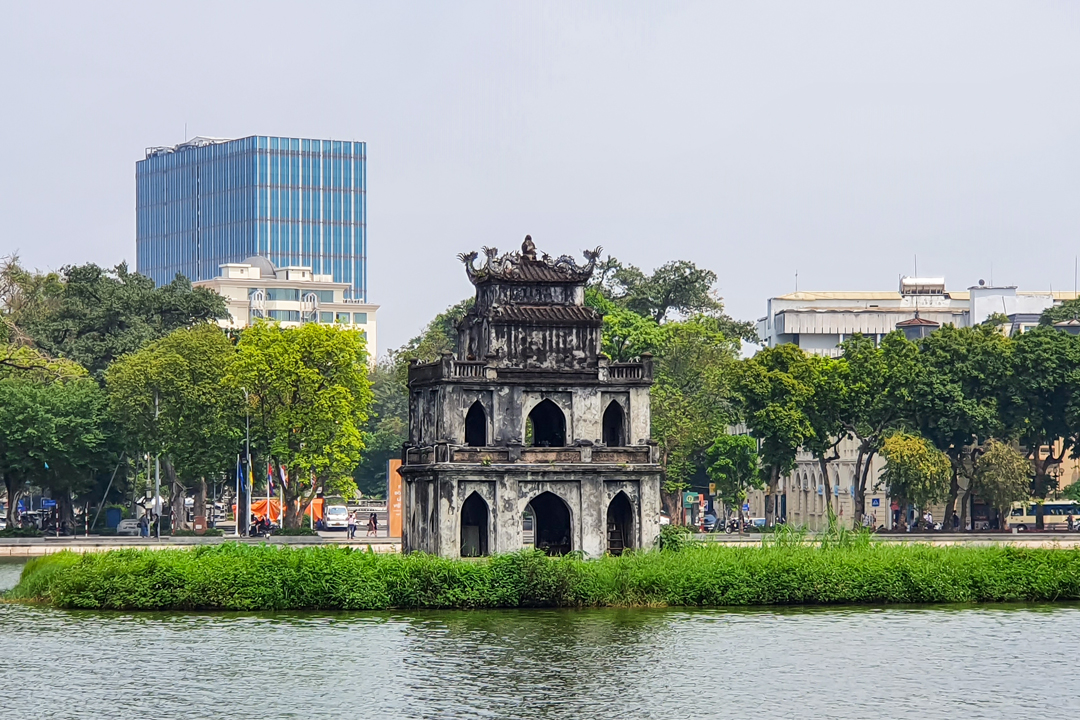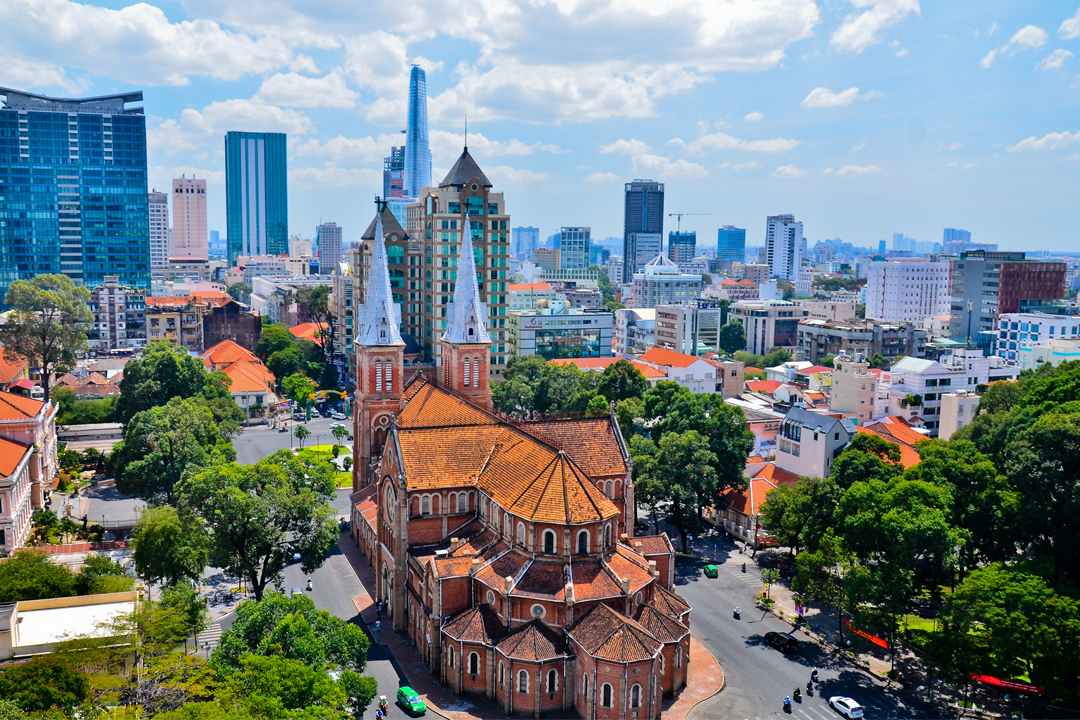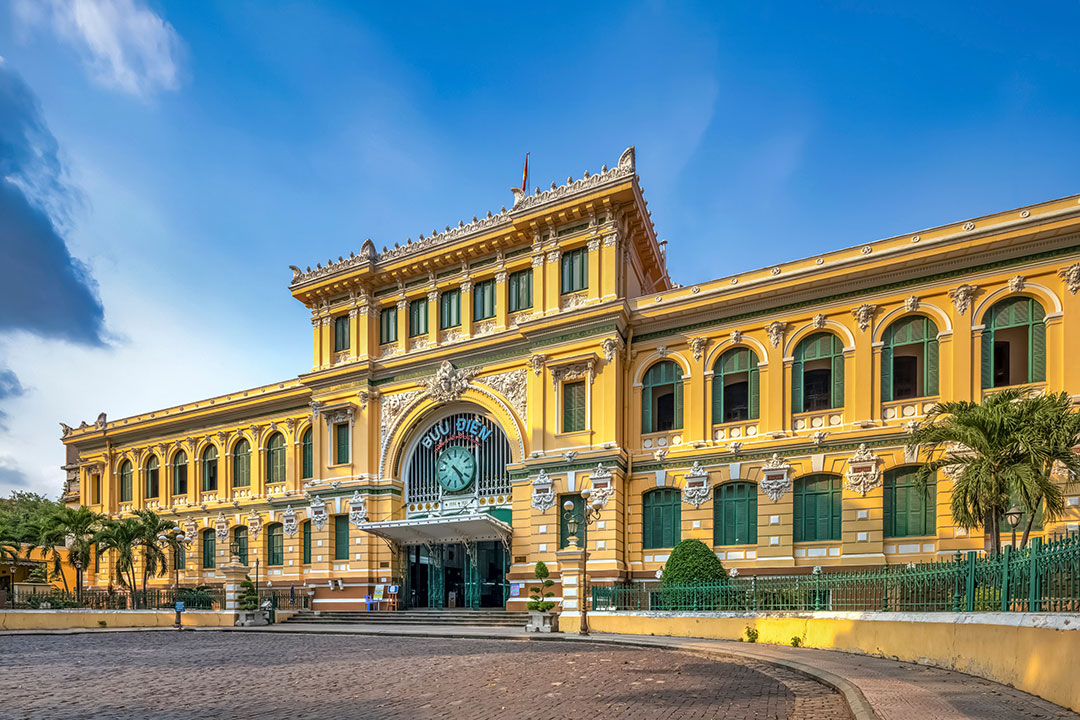Saigon Central Post Office: History, Architecture, Things To Do & Travel Guide
Saigon Central Post Office in the heart of Ho Chi Minh City is more than a postal hub, it’s a journey through history, showcasing a majestic French colonial facade and intricate decorative details. Built in the 1890s and renovated in the 1920s, the building beautifully blends European architectural style with Vietnamese cultural elements. Step inside to explore its vaulted halls, historical maps, vintage telephone booths, and other unique features, all waiting to be discovered with GTrip as your guide.
Overview of the Saigon Central Post Office
Before diving into its architectural and historical highlights, it’s useful to know some basic information about the Saigon Central Post Office.
Where is the Saigon Central Post Office?
Located: 125 Hai Ba Trung Street, Saigon Ward (formerly Ben Nghe Ward, District 1), Ho Chi Minh City
The Saigon Central Post Office is located in the heart of former District 1, making it easily accessible for both tourists and locals. Its central location places it within walking distance of other major landmarks, allowing visitors to explore the area conveniently. The building itself is free to enter, making it an inviting starting point for anyone looking to experience Saigon’s rich history and French colonial architecture.
Opening hours & Entrance fee
When planning your visit, it’s helpful to know the opening hours and entrance policy:
- Opening hours:
- Monday - Saturday: 7:30 AM - 6:00 PM
- Sunday: Closed
- Entrance fee: Free
- Best visiting times: Early morning or late afternoon on weekdays to avoid crowds and enjoy unobstructed photography opportunities
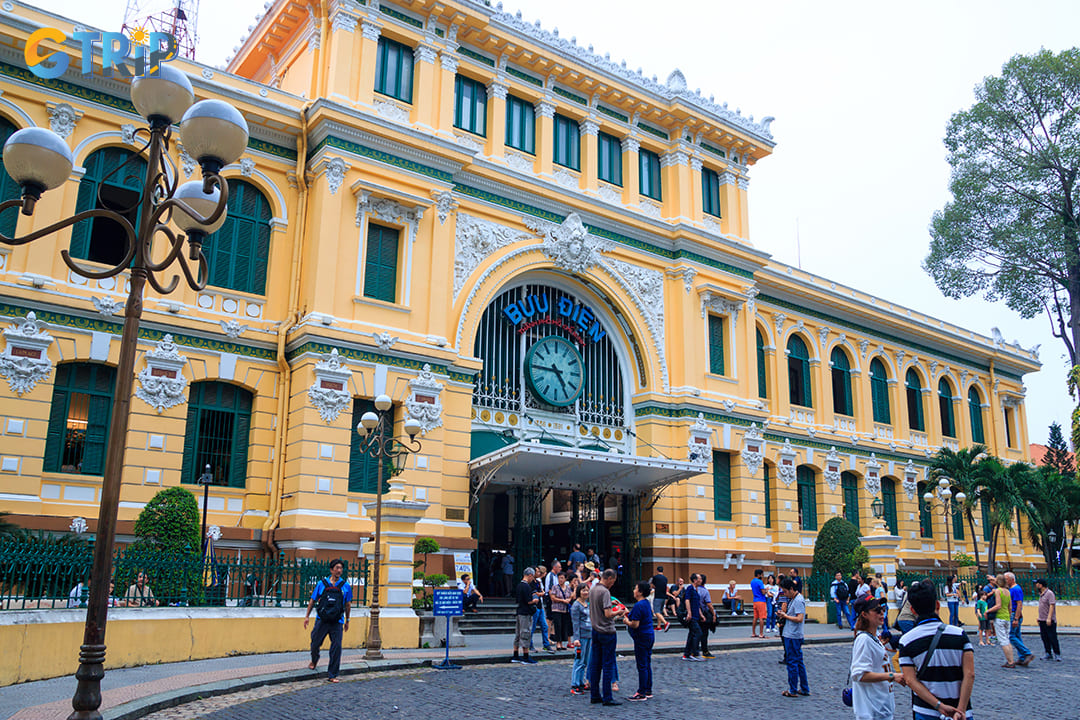
For those looking to avoid crowds, the ideal visiting times are early in the morning right after opening, or late afternoon before closing
How to get to Saigon Central Post Office?
The Saigon Central Post Office is centrally located in former District 1 of Ho Chi Minh City, making it easily accessible from most parts of the city. Typically, some Ho Chi Minh tours will guide you to the Saigon Central Post Office, so you can sign up for a tour to help you avoid some confusion when traveling here.
By taxi or ride-hailing service
The easiest and most direct way to reach the Saigon Central Post Office is by taxi or ride-hailing services like Grab. The journey time from popular areas like Ben Thanh Market or Nguyen Hue Walking Street typically takes around 5 - 10 minutes, depending on traffic.
- Estimated fare: A taxi ride from Ben Thanh Market should cost around 50,000 - 70,000 VND, depending on traffic.
- Tips: Always check that the meter is running or confirm the fare with the driver before starting your ride.
By public bus
Ho Chi Minh City has an extensive public bus system, and several bus routes stop near the Saigon Central Post Office. Here are some of the most convenient bus routes:
- Bus routes: Buses number 50, 93, and 150 pass by the post office.
- Cost: A bus ticket typically costs around 5,000 - 10,000 VND.
Using public buses can be an affordable option but may require more time, especially during peak traffic hours.
By walking
If you are staying nearby in District 1 or exploring the area, walking to the Saigon Central Post Office is a pleasant option. The post office is within walking distance of several other major landmarks:
- From Ben Thanh market: A 10-minute walk (about 700 meters).
- From Nguyen Hue walking street: A 5-minute walk (about 300 meters).
- From Notre-Dame Cathedral: A 5-minute walk (about 400 meters).
Walking allows you to enjoy the architecture and bustling atmosphere of the city, and it’s a great way to experience the local vibe.
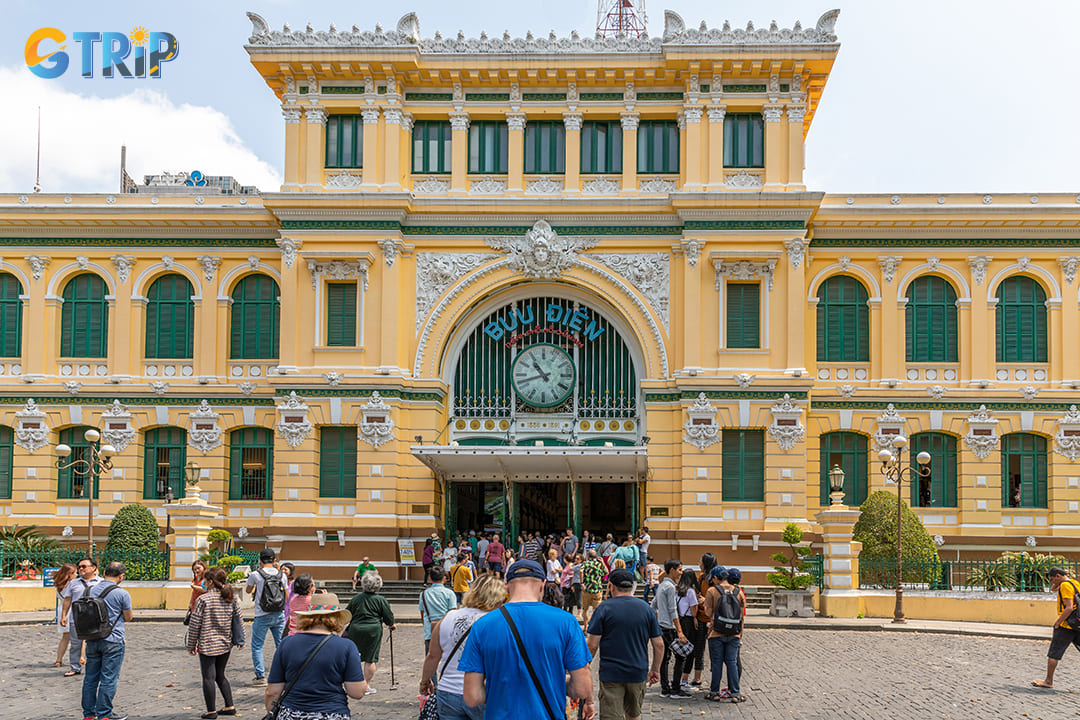
If you are staying nearby in District 1 or exploring the area, walking to the Saigon Central Post Office is a pleasant option
By cyclo or motorbike
For a more local experience, you can choose a cyclo or rent a motorbike to get to the post office. Cyclo rides are a popular way to explore the city at a relaxed pace, but be sure to agree on the price before starting the ride.
- Cyclo ride: Prices usually range between 50,000 - 100,000 VND for a short trip, depending on the distance.
- Motorbike rental: Rent a motorbike for about 100,000 - 150,000 VND per day, which can provide more flexibility to explore the area.
By bicycle
Bicycle rentals are available at shops, hotels, or via TNGo in public areas, typically costing 30,000–70,000 VND per day. With bike lanes throughout the city, especially near the Saigon River, and a pedestrian-friendly area around the Saigon Central Post Office, cycling is a safe, enjoyable, and eco-friendly way to visit the landmark.
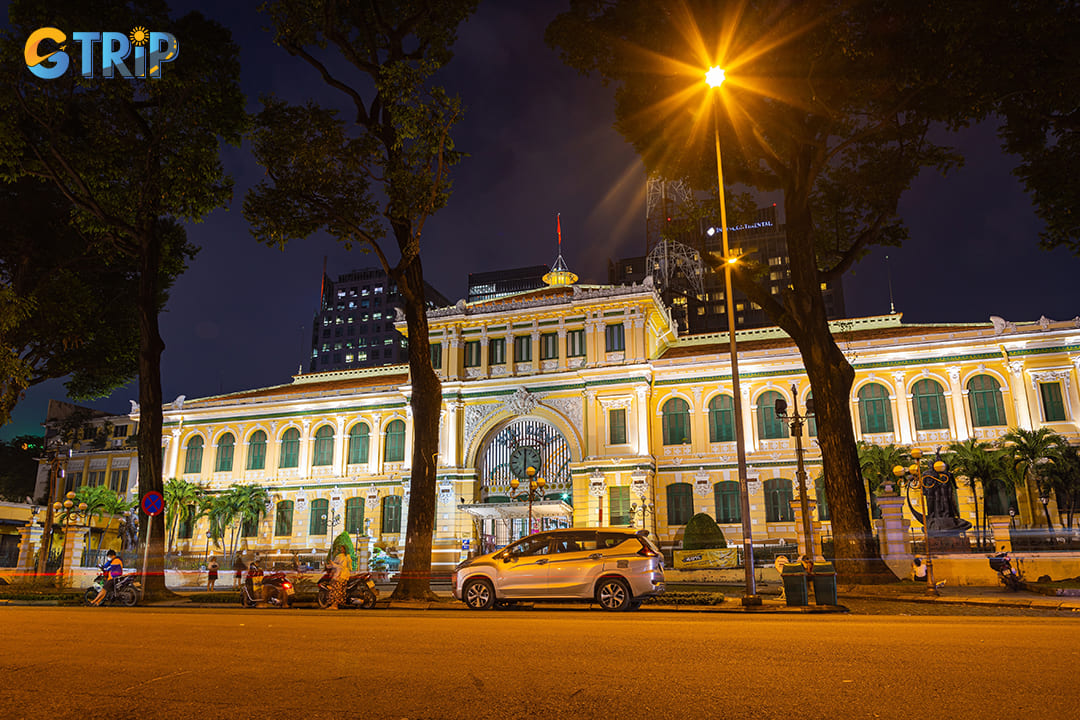
Cyclo rides are a popular way to explore the city at a relaxed pace, but be sure to agree on the price before starting the ride
History of Saigon Central Post Office
The Saigon Central Post Office stands as a vivid witness to the city’s storied past, reflecting both colonial ambitions and Vietnam’s cultural transformations. Exploring its history provides valuable insights into its significance and enduring legacy.
The original construction and renovation phases
Constructed between 1886 and 1891, the Saigon Central Post Office was part of a sweeping urban development plan initiated by the French colonial administration in Vietnam. Designed by Marie-Alfred Foulhoux, with contributions from Gustave Eiffel (famed for the Eiffel Tower), the post office was intended to signify the modernization and European influence introduced under French rule. It served primarily as a communication hub, connecting Vietnam with the wider world via the burgeoning telegraph and postal systems.
In the 1920s, the post office underwent renovations, led by French architects, that further enhanced its elaborate design. These renovations were crucial in maintaining the aesthetic integrity and operational functionality of the structure over the years, allowing it to adapt to technological changes while preserving its historical appeal. This phase highlighted the blend of resilience and transformation characteristic of Saigon’s development journey.
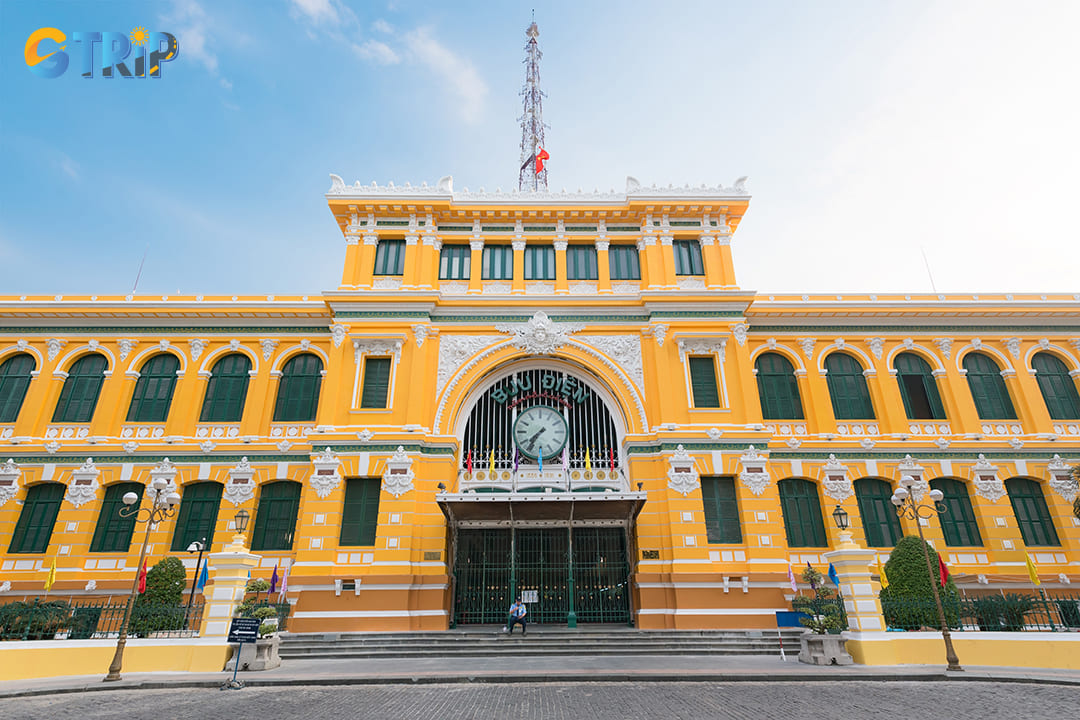
This post office reflects both the colonial aspirations and cultural transformations of Vietnam
The post office's role in Saigon's development
Beyond its architectural beauty, the Saigon Central Post Office played a crucial role in the sociopolitical and economic development of Saigon. As a major communication hub, it enabled efficient postal and telegraph services, linking the city with international networks. This connectivity was instrumental in fostering trade, commerce, and cultural exchanges, further bolstering Saigon's status as a prominent colonial city.
The post office also served as a community gathering spot, a place where locals would meet and connect. Over time, it became a symbol of Vietnamese resilience and adaptability, enduring through periods of colonization, war, and eventual reunification. Today, it continues to be a pivotal landmark, attracting tourists and locals alike and showcasing the city's rich history and architectural heritage.
Through its grand architecture and lasting use, the post office reflects Ho Chi Minh City's layered history of colonialism, cultural fusion, and urban growth. Its legacy is cemented in the cultural identity and historical tapestry of the city, making it a must-visit for those interested in exploring Vietnam's colonial past and its journey toward modernity.
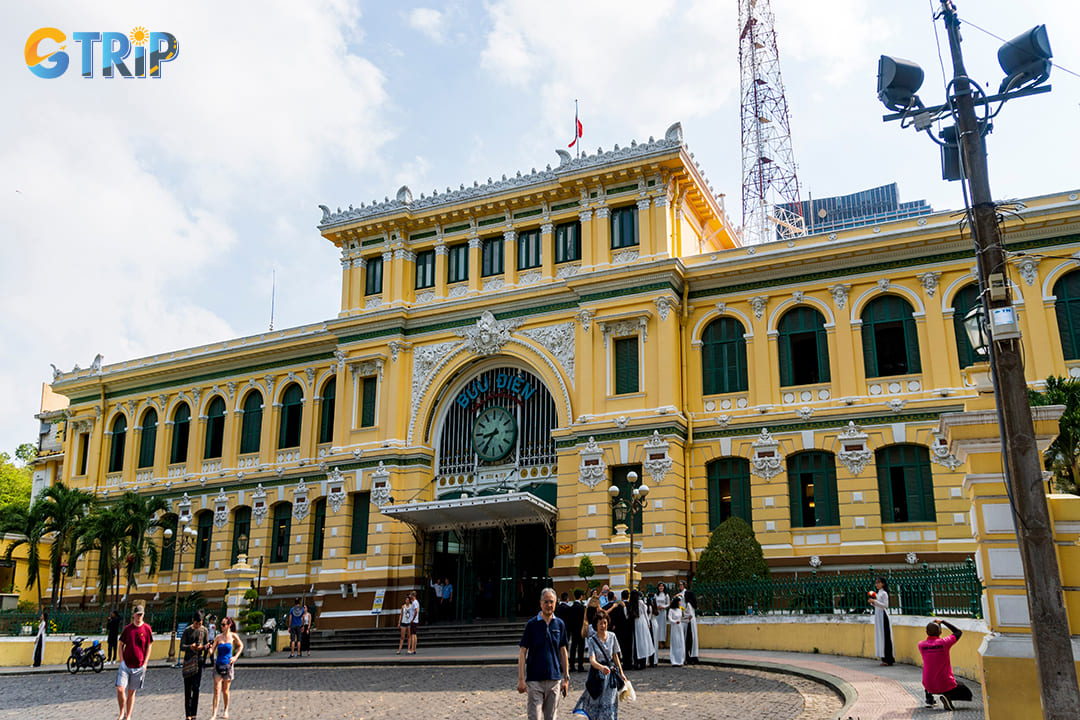
The post office also served as a community gathering spot, a place where locals would meet and connect
Saigon Central Post Office Architecture: Exterior & Interior
Saigon Central Post Office is a prominent French architectural work, harmoniously combined with elements of Vietnamese culture. Over 100 years old, the building serves both as a functioning post office and a tourist attraction, featuring refined architecture, distinctive decorative details, and clear historical significance.
Exterior of the post office
The exterior immediately captivates visitors with its grand design, showcasing the elegance and artistry typical of French colonial architecture.
Facade and Entrance
As one approaches, the striking golden facade, accented with delicate white trims, creates a prominent contrast. The large arched entrance, adorned with intricately carved Neo-Renaissance reliefs, gives visitors the impression of stepping into a European palace. Above the arch, a large clock has been running continuously for over 130 years, becoming a timeless symbol of the building. Arched windows, decorative ironwork, and finely crafted moldings further highlight the classic features characteristic of French architecture.
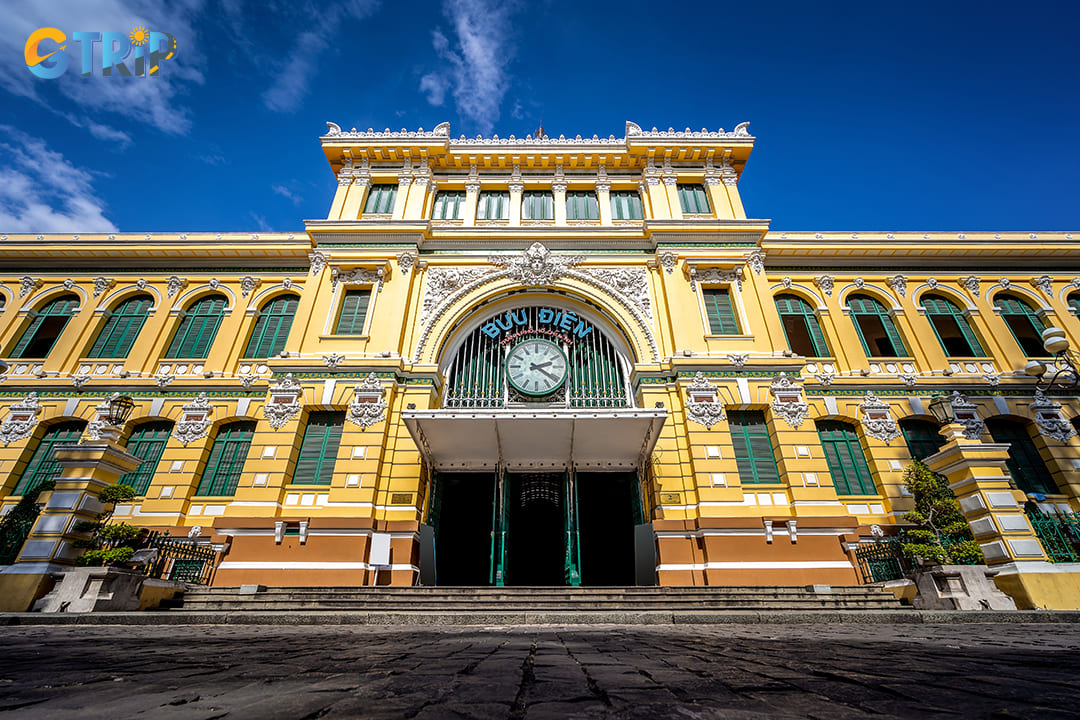
The symmetry of the design is meticulously maintained, with Corinthian pilasters carved intricately along the walls, lending the building a majestic aura
Decorative Details and Scientific Symbols
Moving closer, visitors notice the finer details that enrich the building’s historical narrative. The names of famous inventors such as Benjamin Franklin, Alessandro Volta, and Michael Faraday are engraved on rectangular panels extending from the center to both sides, emphasizing the post office’s key role in the information network during the French colonial period. The balance of colors, symmetrical layout, and decorative motifs not only enhance elegance but also harmonize with local cultural elements.
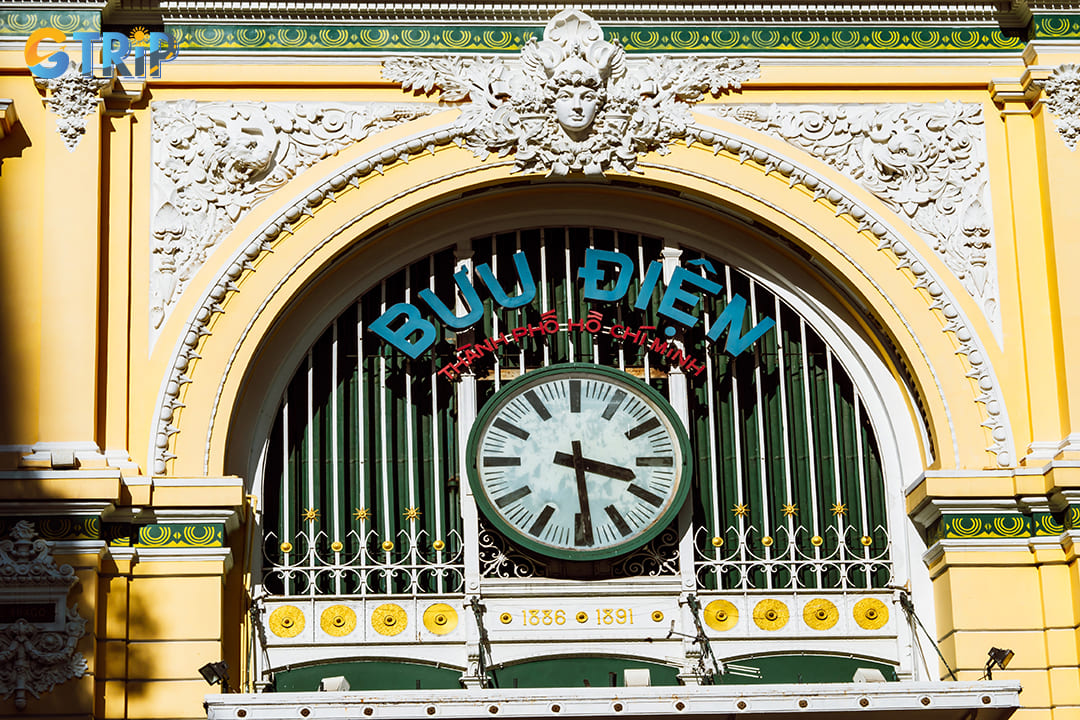
One of the defining features of the Saigon Central Post Office is its iconic clock, mounted prominently above the main entrance
Interior of the post office
Stepping inside, the interior architecture continues to impress, revealing both grandeur and historical depth.
Vaulted Ceiling and Spatial Architecture
The post office stands out with its high, wide, and graceful vaulted ceiling, supported by decorative iron columns on both sides. This design creates a sense of spaciousness, elegance, and naturally draws the eyes upward.
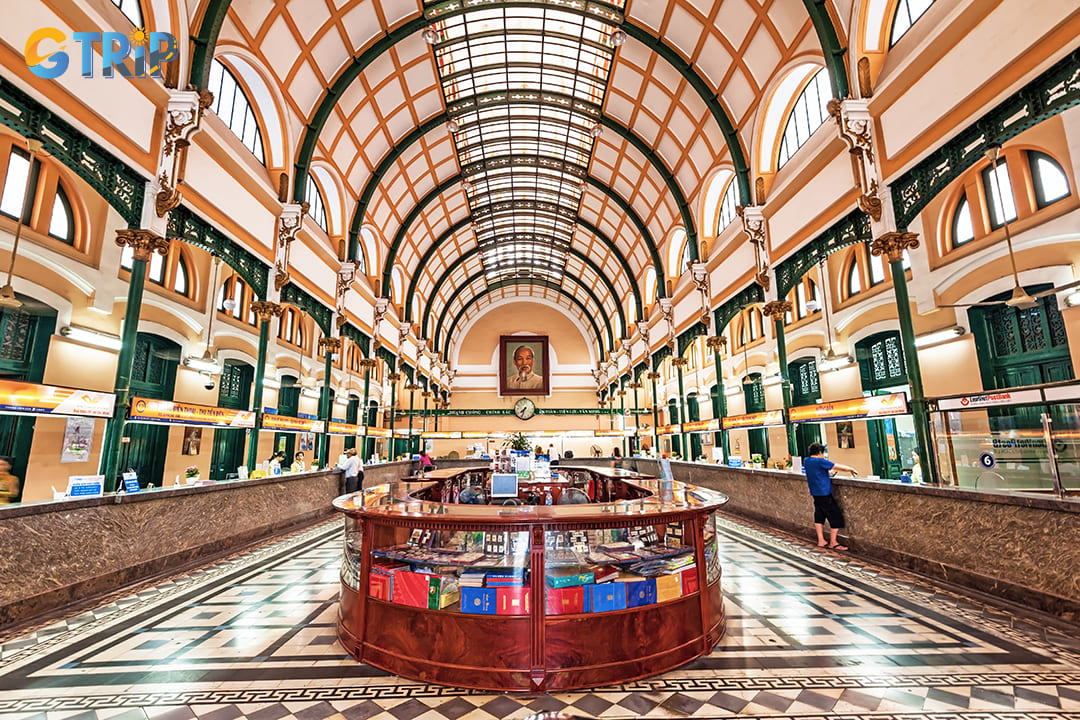
Central to the spatial layout is the long, curved wooden counter, a nod to the building’s continuous operation as a post office
Portrait of Ho Chi Minh
At the heart of the main hall, attention is drawn to a large portrait of President Ho Chi Minh. This prominent display creates a striking contrast between French architectural style and Vietnam’s national identity, highlighting the country’s historical journey from the colonial era to independence.
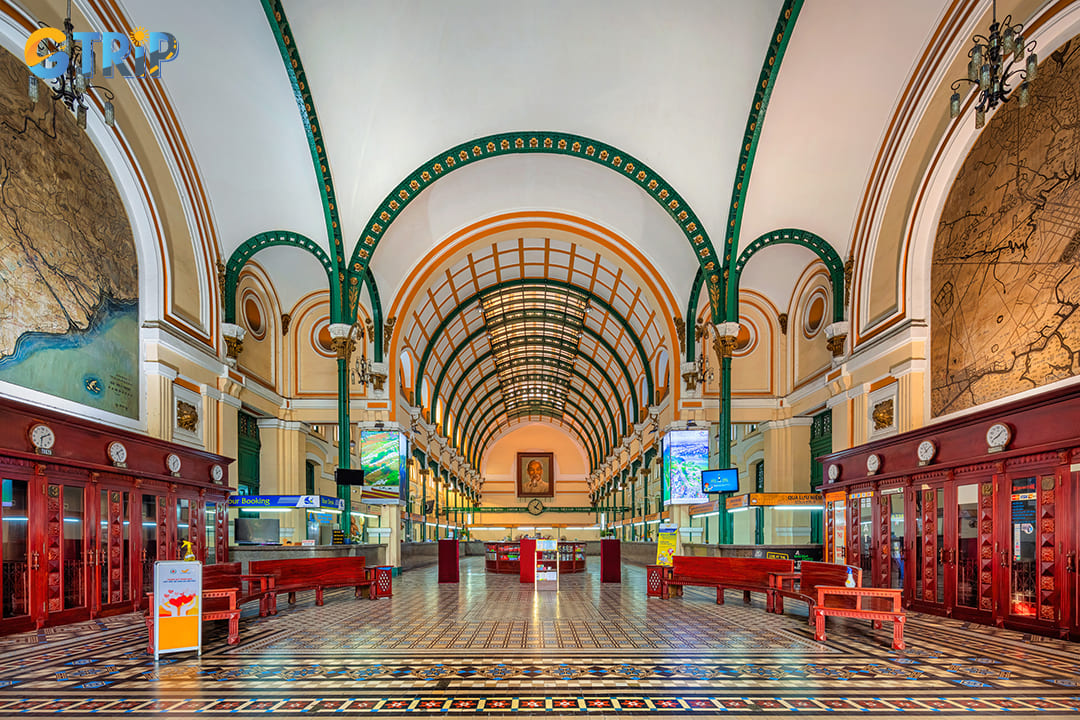
Stepping inside, you are enveloped by a spacious hall that showcases both form and function
Historical Maps
Visitors can also explore historical artifacts that illustrate the post office’s central role in communication. Two large antique maps hang on either side of the main hall – “Saigon et ses environs 1892” and “Lignes telegraphiques du Sud Vietnam et Cambodge 1936” – serving not only as decorative elements but also as records of the telegraph networks and communication systems of the time.
Vintage Wooden Telephone Booths
Adding to the nostalgic ambiance, some vintage wooden telephone booths have been preserved. Once used for long-distance calls in the early 20th century, these booths now serve as charming photo spots or have been repurposed as mailboxes, maintaining their historical value and offering a “step back in time” experience before the digital era.
Auxiliary Interior Features
Finally, practical yet elegant features complete the interior. Rows of wooden benches along the main hall provide resting spaces for visitors, while the tiled floor with vintage border patterns enhances aesthetic appeal and complements the refined interior design.
Things to do when visiting Saigon Central Post Office
When visiting the Saigon Central Post Office, there are some things to do that will help you appreciate the historical and architectural beauty of this iconic building. Here are some recommendations:
1. Take cinematic photos with the stunning structure
The Saigon Central Post Office is one of Ho Chi Minh City’s most photogenic landmarks. The best spot is in front of the main entrance, where the striking yellow facade, grand arched windows, and iconic clock create a stunning backdrop. Standing on the steps highlights the intricate Beaux-Arts details, while a photo under the clock adds a historical touch, symbolizing the building’s long-standing role in Vietnam’s communication history.
Inside, the grand main hall impresses with its high vaulted ceilings, marble pillars, and elegant symmetry. Positioning yourself in the center captures the hall’s full depth, enhanced by natural light through arched windows. Antique wooden counters along the hall provide a classic, nostalgic atmosphere, and the vintage telephone booths offer another charming spot for photos, recalling a pre-digital era of communication.
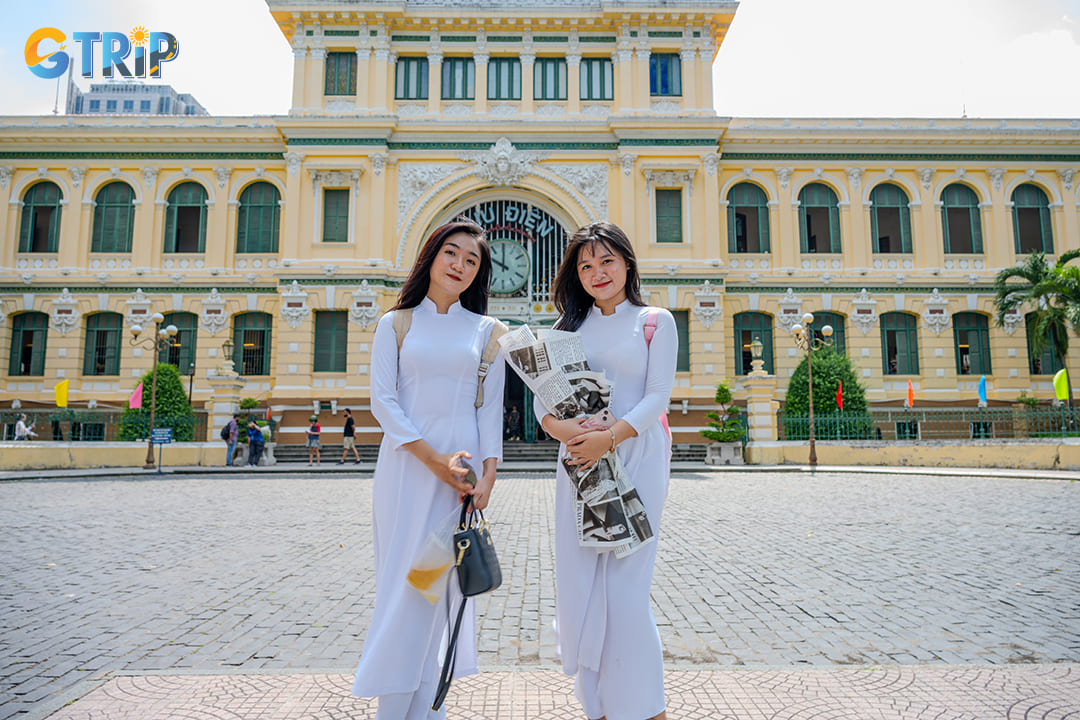
One of the best places to take a photo is right in front of the main entrance
2. Sending a letter or postcard that is written by hand
The Saigon Central Post Office continues to operate as an active post office, offering tourists the opportunity to engage in a charming, traditional method of communication. While exploring this historical landmark, take the time to write a heartfelt letter or send a postcard to friends and family. It’s a delightful way to connect with loved ones, while also immersing yourself in the rich history of the building.
The post office has a variety of postcards featuring iconic images of Saigon and Vietnam, making them perfect souvenirs or personal messages. Not only will you be sending a piece of history, but you'll also experience the timeless joy of mailing something by hand.
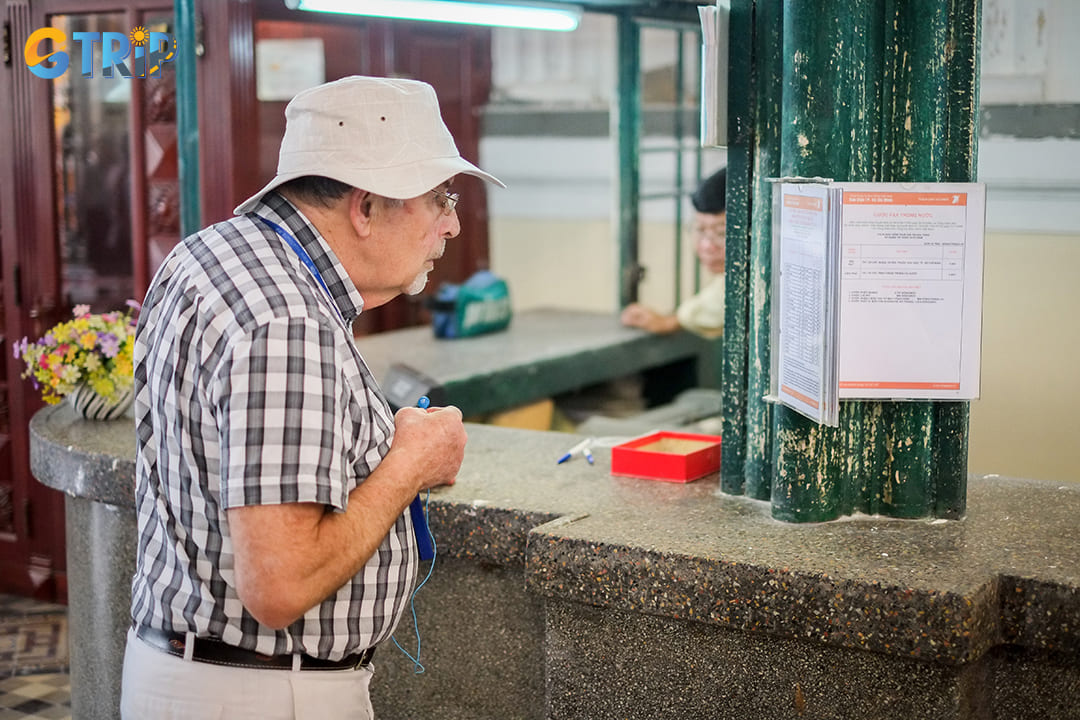
The Saigon Central Post Office continues to operate as an active post office
3. Explore the gift shops and souvenir stalls
Inside and surrounding the Saigon Central Post Office, you'll find a variety of small gift shops and souvenir stalls offering an array of local goods that reflect the rich culture of Vietnam. These shops are perfect for tourists looking to take home a piece of Saigon’s charm.
You can find beautifully crafted postcards depicting iconic landmarks of Ho Chi Minh City, such as the Notre Dame Cathedral and the post office itself. These postcards are not just souvenirs but also a great way to send a piece of Saigon to loved ones back home. In addition to postcards, many shops offer traditional Vietnamese handicrafts, including lacquerware, silk scarves, and embroidered textiles. These items, often handmade by local artisans, showcase the craftsmanship and artistic traditions of Vietnam.
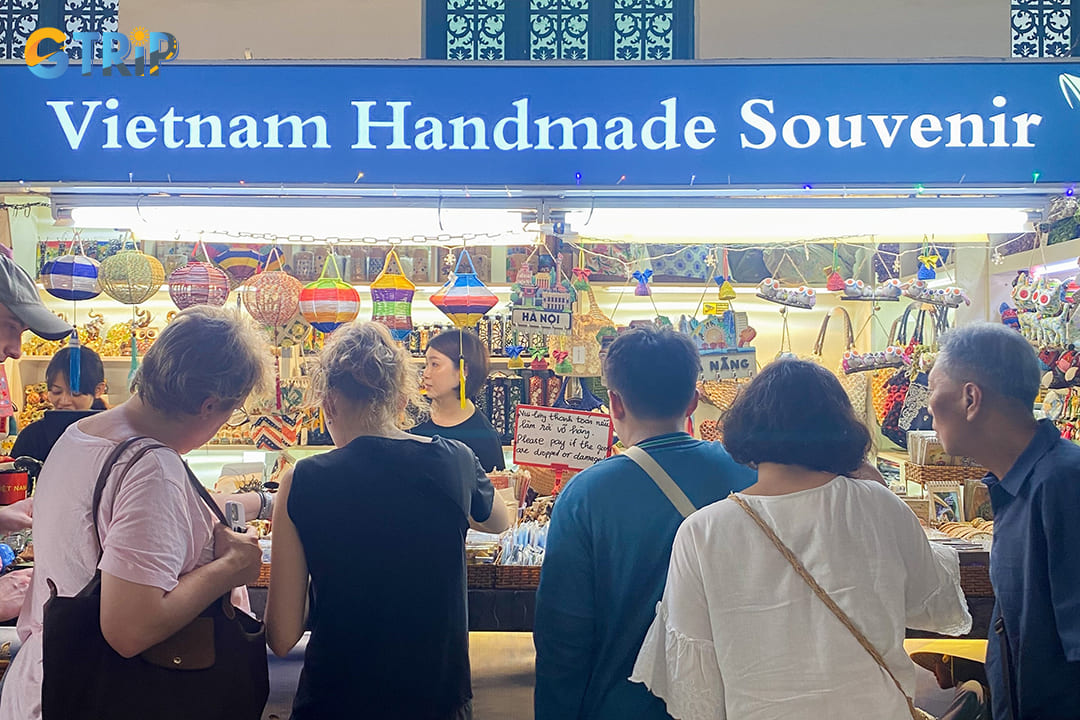
You can find a variety of small gift shops and souvenir stalls offering an array of local goods that reflect the rich culture of Vietnam
The stalls also sell a range of small trinkets, such as keychains, magnets, and miniature replicas of the Saigon Central Post Office, perfect for a lightweight and memorable keepsake. For those interested in the culinary side of Vietnamese culture, you’ll also find vendors offering local spices, teas, and coffee beans, which are a great way to bring home the flavors of Vietnam.
Shopping at these local stalls provides you with unique souvenirs and helps support the artisans and small businesses that contribute to the local economy. These gift shops and souvenir stalls add an extra layer of cultural immersion to your visit, allowing you to bring home more than just memories of the post office.
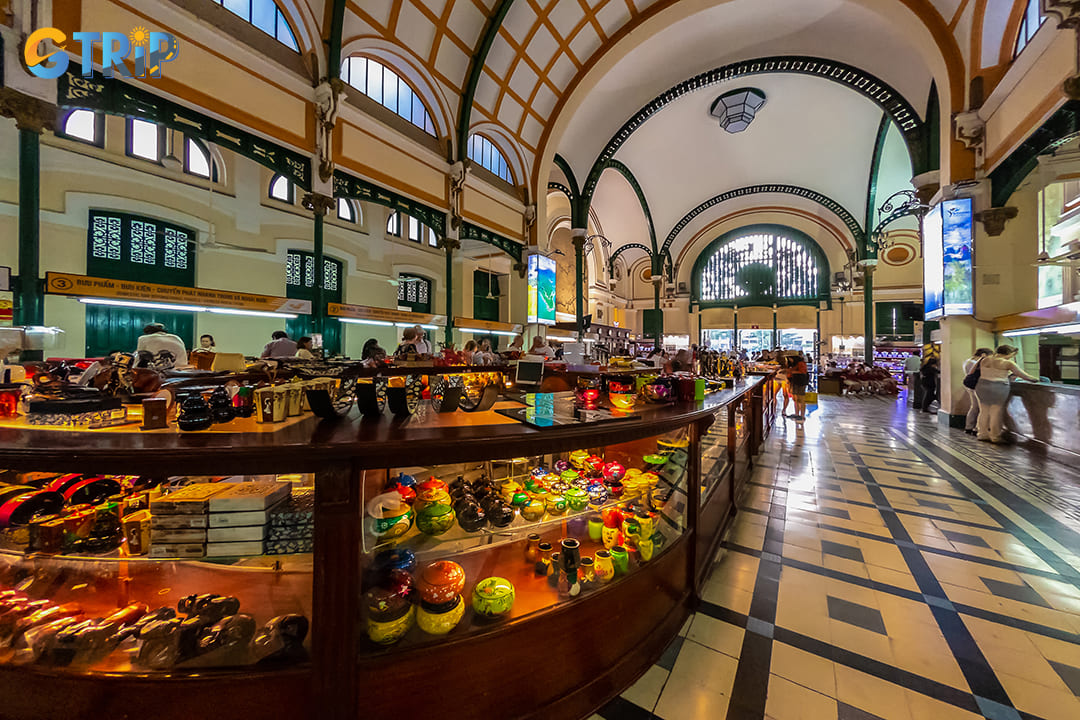
Shopping at these local stalls provides you with unique souvenirs and helps support the artisans and small businesses
Nearby attractions to explore from Saigon Central Post Office
When visiting this iconic post office, the rich cultural and historical tapestry of Ho Chi Minh City beckons exploration beyond the grand arches of this architectural marvel. Here, we delve into the nearby attractions that should grace the itinerary of any tourist keen to fully immerse themselves in the Saigon experience.
Notre Dame Cathedral of Saigon (350 m)
Just a stone’s throw from the Saigon Central Post Office stands the majestic Notre Dame Cathedral of Saigon, an architectural gem that anchors the city’s history in the French colonial past. Built between 1877 and 1880, this cathedral showcases neo-Romanesque architecture, featuring a red brick facade from Marseilles and stained glass windows depicting biblical scenes.
- Visitor experience: Tourists often marvel at the twin bell towers, rising approximately 58 meters, offering a picturesque silhouette against the city skyline. Until recent renovations commenced, you could attend services or simply reflect on the tranquil ambiance of its vast interiors, resonating with spiritual serenity.
- Cultural significance: The cathedral holds religious significance for many Vietnamese Catholics and stands as a testament to the historical French influence. It serves both as a place of worship and a testament to the enduring legacy of a colonial era.
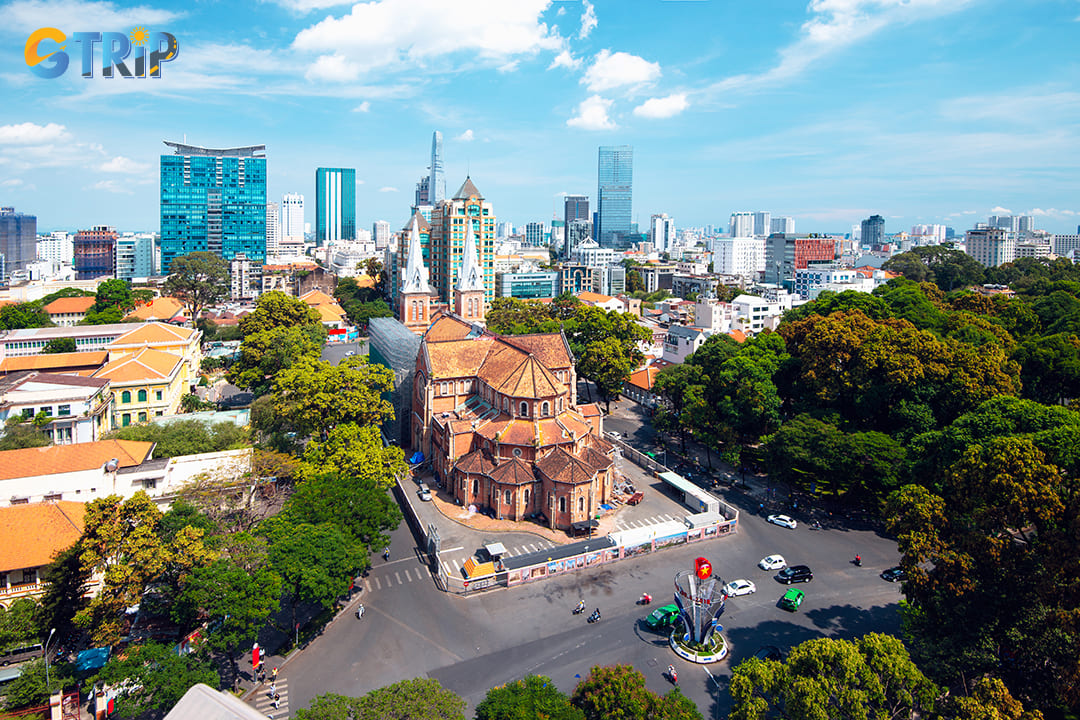
The majestic Notre Dame Cathedral of Saigon is an architectural gem that anchors the city’s history in the French colonial past
Independence Palace (500 m)
A short walk or drive will take you to the Independence Palace, a symbol of the tumultuous history of Vietnam. Formerly the Reunification Palace, this historic site marked the end of the Vietnam War in 1975 when a North Vietnamese tank crashed through its gates.
The palace, designed by architect Ngo Viet Thu, exemplifies 1960s modernist architecture with its distinctive concrete facades and sprawling lawns. You can explore various rooms, from the President's office to the cinema, along with preserved bunkers that reveal the war’s tactics and the era’s socio-political context. Guests are guided through its historic halls, with tours elaborating on the geopolitical narratives that unfolded within its walls. This juxtaposition of past and present encapsulates Vietnam’s journey towards unification and peace.

A short walk or drive will take you to the Independence Palace, a symbol of the tumultuous history of Vietnam
These landmarks collectively provide an enlightening narrative of Saigon's evolution from a colonial hub to a vibrant contemporary city. Collectively, they offer more than mere glimpses into history. They foster an immersive understanding of Vietnam’s cultural fabric, underscoring how history, architecture, and modernity coalesce in the heart of Ho Chi Minh City. Each contributes to the tapestry of experiences awaiting discovery, making a visit to this historic district rich and fulfilling.
Travel tips for tourists visiting Saigon Central Post Office
- Dress comfortably: Wear lightweight, breathable clothing and comfortable shoes to stay cool and comfortable in the humid climate.
- Bring a hat and sunscreen: Ho Chi Minh City can be hot, so wearing a hat and applying sunscreen will helprotect you from the sun while walking around the area.
- Respect the local customs: Be mindful of the post office’s active operations and avoid disturbing locals who are conducting postal business.
- Photography etiquette: Take photos of the building’s architecture, but always ask for permission before photographing people working inside.
- Check for special events: Sometimes the post office hosts cultural or historical exhibitions; check in advance for any special events or exhibitions during your visit.
- Exchange currency for small purchases: Carry some Vietnamese dong for small purchases at souvenir stalls as cash is preferred by many vendors.
- Avoid peak traffic times: Be mindful of heavy traffic during rush hours, and consider using a taxi rideshare service to avoid delays.
- Learn a little Vietnamese: Learn a few basic phrases like "xin chao" (hello) and "cam on" (thank you) enhance your experience.

You can find a variety of small gift shops and souvenir stalls offering an array of local goods that reflect the rich culture of Vietnam
In conclusion, the In conclusion, the Saigon Central Post Office is more than a functional building. it is a testament to Ho Chi Minh City’s rich history and cultural charm. Blending French colonial architecture with local stories and historical significance, it offers a rare glimpse into the city’s past while remaining an active part of its present. To make the most of your visit, consider joining a guided city tour with GTrip – Vietnam Travel Agency, where expert guides provide historical context, engaging stories, and deeper insights into landmarks like the Saigon Central Post Office.

